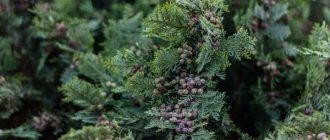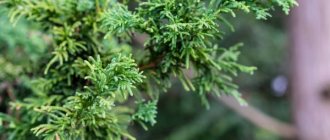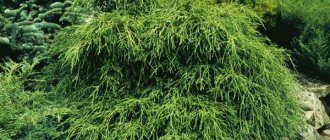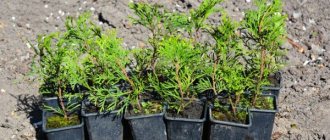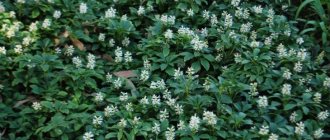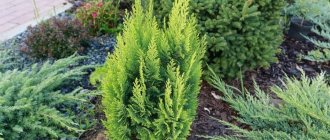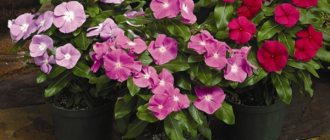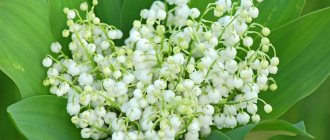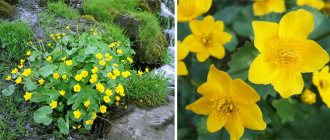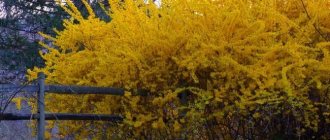Description of Boulevard cypress
Cypress trees are a genus of the Cypress family, they are trees and shrubs with needles of a characteristic structure, come in different heights and are characterized by slow growth. They are found naturally only on the Japanese Islands. They are slightly different from cypresses - their branches are located in the same plane, they have small cones and increased resistance to cold. They like it on soils with sufficient moisture levels.
Their wood is of very high quality; many varieties of these plants have been bred. One of them is Bulevard (also called Bulevar or Boulevard) - with awl-shaped needles reaching 5 cm in length, the shoots are slightly bent inward at the ends. In winter, the Boulevard cypress becomes grayer. This variety in the description has a beautiful blue color with a silver tint.
Cypress Boulevard can be seen in the photo:
Dimensions of Boulevard cypress
The tree grows up to 5 m in height, but grows very slowly, which is typical for almost all representatives of the genus. This is especially noticeable at a young age. On average, the Boulevard pea-bearing cypress grows 10 cm per year, which allows it not to lose its decorative effect for a long time. The crown of the tree is symmetrical, in the shape of a pin.
Winter hardiness of Boulevard cypress
Cypress pea boulevard is a frost-resistant variety, but in Siberia and the Urals it can freeze slightly. In regions with harsh winters, it needs shelter. Due to this characteristic, it is widespread in England, which does not have a warm climate.
Description of the variety
Habit
Under natural conditions, pea cypress grows in mountainous areas and reaches a height of 25 m. Trees of the selection variety 'Boulevard' do not reach such a height under Russian conditions. The delicate cypress needles cannot withstand the harsh conditions of the Russian winter, freeze and fall off. Landscape designers have shifted their emphasis towards low-growing plants, like the Boulevard variety. The usual plant height is 0.8–1.2 m, sometimes 2 m.
The crown shape is conical with a smooth top, symmetrical, often pin-shaped. Low trees with branches growing almost from the ground and widely spread to the sides are similar in appearance to shrubs. The crown is thick and lush. An adult specimen grows up to 1.2 m in diameter.
Low trees with branches growing almost from the ground and widely spread to the sides are similar in appearance to shrubs.
It is characterized by low-lying needles of a soft turquoise color, shimmering with a silvery sheen in the sun’s rays. In winter, the needles take on a grayish-purple hue. The length of soft, non-thorny needles reaches 6 mm. The ends of the conifer needles bend inward, giving the plant an openwork fluffy appearance.
The fruits are cones, resembling the size of peas, which is fixed in the name of the plant. The length of the fruit does not exceed 8 mm.
The bark is brown with a reddish tint.
It is characterized by low-lying needles of a soft turquoise color, shimmering with a silvery sheen in the sun’s rays.
Planting cypress pea Boulevard
Cypress thrives in a humid coastal climate. Dry air and lack of moisture cause him significant discomfort. Regions such as Astrakhan, Volgograd, Saratov regions will not be very favorable for its cultivation. In general, planting and caring for Boulevard cypress is not difficult. The plant should receive about 400 mm of precipitation during the summer season. If this indicator is not achieved, then additional watering is necessary.
When planted in a dry and shaded place, the cypress tree may die. Also, you should not place it next to large trees that can oppress a young bush with their developed root system. Proximity to the surface of groundwater and stagnation of moisture will also become negative factors.
Advice! To ensure faster rooting of seedlings, they must be treated with Kornevin.
The ideal place for planting the Boulevard pea-bearing cypress variety would be a sunny place with fertile, moist soil. Gentle slopes in the southern and western directions, protected from strong winds, are well suited.
Landing dates
Cypress pea Boulevard is usually planted in early spring, after the soil has warmed up, but autumn preparation of the planting hole is required. Fertilizers are added there and covered with film for the winter so that the contents are well rotted. In terms of timing, it is important to arrive at the moment when the earth has already warmed up, but the trees and shrubs have not yet begun to grow.
Soil preparation
Boulevard cypress requires fertile soils with good drainage, but at the same time sufficiently moist. The acidity level should be at 5 pH. It is easily achieved by adding peat to the soil. Since the tree will receive nutrients from the soil for several more years, care should be taken to apply fertilizers. A mixture of turf soil, sand and peat is placed in the planting hole in a ratio of 1:1:2.
Preparation of planting material
Cypress pea Boulevard is purchased for many years, so the choice of seedling should be approached responsibly. It is best to purchase plants in special nurseries, where you can also consult with specialists. The most important thing is to inspect the roots of the seedling when purchasing - they should not be open, because the cypress tree will die at the slightest drying out.
Unscrupulous sellers may display containers with replanted plants. To check the quality of the seedling, you need to turn the container upside down - in normal specimens the soil does not spill out, but the earthen lump falls out entirely. The branches should be flexible and the needles should be dry to the touch.
Landing rules
The planting pit is prepared in the fall. The size is maintained within 90 cm depth and 60 cm width. At the bottom there is a 20 cm layer of drainage made of gravel or expanded clay. When planting Boulevard cypress, you must ensure that the root collar rises 15 cm above the soil layer. The seedling is fixed at a support and mulched with wood chips or peat.
Landing
Reproduction
Typically, pea cypress is purchased in specialized stores or nurseries. Consumers can propagate Boulevard themselves. There are three ways to do this.
- Seeds are a convenient but labor-intensive method. The seeds are collected, dried, stratified, and then germinated in a container. Grown seedlings are planted in the ground.
- Layering is the easiest way. A branch spreading along the ground is cut and buried in the ground. Gradually, roots appear from the cut, after which the new plant is separated from the mother one.
- Cuttings are a reliable and effective way. Cuttings are prepared in spring from young stems. The lower part of the blanks is freed from needles and planted in pots with fertilized soil. The container with the handle is covered with waterproof material to saturate the space with water vapor. Under favorable conditions, roots appear in 1.5–2 months.
Selecting a location
An important point is the choice of place to plant the plant.
- Open, moist and fertile areas without active shading are suitable. Shade and dryness negatively affect the condition of plantings and lead to depletion of vitality.
- Slightly acidic or neutral soil is suitable for planting the plant. Drained loamy soil containing plenty of nutrients is best.
- The presence of stagnant water leads to rotting of the root system. It is not advisable to plant plants near water bodies.
- The location of large trees nearby, whose roots occupy a fairly large area, has a negative effect on the development of the plant.
- Western or southern gentle slopes are an ideal place for planting seedlings. This arrangement protects the plantings from the influence of strong cold winds.
The increase in height of the pea cypress occurs unevenly. At first it grows slowly - up to 10 cm per year; with age, the growth of the plant accelerates.
Terms and Conditions
When planting cypress trees, it is important to meet the necessary conditions.
In the fall, the main work is done to prepare the planting hole. The optimal dimensions of the pit are 60x90 cm.
Drainage is placed at the bottom of the hole. Gravel, broken brick, and expanded clay are used as drainage. The thickness of the drainage layer is at least 20 cm.
The hole is filled with earth mixture and left in this form for the winter.
Cypress trees are planted in early spring. By this time, the earth had already warmed up, and active growth of planting material had not begun. When planting, the root collar is left above ground level by about 20 cm.
To give stability, the young tree is tied to a support.
The space around the trunk is mulched with shavings, wood chips or peat.
The first years of life require a special approach to providing conditions for the life of the Boulevard cypress. It is covered in winter and early spring.
Winter care
The Boulevard variety adapts well to winter conditions if certain conditions are met:
- In winter, the crown of the tree is sprinkled with snow to prevent the needles from freezing under the influence of frosty winds.
- The root part, located under the snow cover, is not covered to avoid stagnation of moisture and rotting of the roots.
Protection from insolation and watering
In early spring, bright sun rays reflected from the snow cover pose a danger to delicate needles. To maintain the natural beauty of the needles in the first years of life, the plant is covered from direct sunlight during and after the snow melts. Without shading, areas with burns appear on the coniferous cover; the needles burn out in places facing the sun. This significantly worsens the appearance of the plant. They protect the plant with awnings, burlap, cardboard shields, and fabric fences. Fences somewhat spoil the design appearance of the site, but they preserve the life and beauty of the plant.
Boulevard cypress tolerates both shaded and sunny areas well. During the dry season, the cypress tree sheds some of its needles. It dies and turns brown.
If the soil is dry, the plant requires regular watering, including in the winter. The best watering option is sprinkling, when the crown receives moisture along with the roots. Young seedlings are sprayed daily.
Important! When working with Boulevard cypress, the need for human protection is taken into account, since the plant is poisonous.
Boulevard haircut
There are 2 types of cypress haircuts:
Sanitary trimming of the crown is carried out in early spring or autumn.
In spring shoots are cut:
When cutting with scissors, they change the size of the plant, give it a certain shape, trying to create smooth outlines of the plant’s contour. It is better to start shaping the tree 1–2 years after planting.
Location on the site
Pea cypress looks great in landscape compositions. It is good in both group and single plantings. It is organic both in the structure of large park areas and in small garden plots.
The crown of the plant lends itself well to shaping. To increase decorativeness or create a certain design style, the development of the crown is directed. Regular trimming refreshes and maintains the color of the crown.
Boulevard cypress does not lose its decorative qualities for 10 years. During this time, other seedlings grow, which will make it possible to renew the plantings on the site.
Caring for Boulevard cypress
Although the Cypress pea Boulevard is not very demanding in care, it is necessary to follow some rules. The main characteristics of this plant require attention to watering, pruning and wintering.
Watering and fertilizing
One of the important factors in cypress agricultural technology is watering. It must be regular and abundant to maintain the required level of soil moisture. Cypress pea Boulevard reacts extremely poorly to heat and dryness. About 10 liters of water should fall under one plant per week. If the tree is in a hot climate, then water it several times a week.
Cypress pea Boulevard is very good at sprinkling; it should be done early in the morning or in the evening, but so that the needles have time to dry before nightfall. Too much humidity will cause fungal and bacterial infections. After watering, it is necessary to loosen the soil and remove weeds, if any.
The first fertilizing with organic matter and mineral complexes is done 3 months after planting. For a young tree, the concentration is half as much, so as not to burn the tender and fragile roots. Adult plants are fertilized from spring to mid-summer, every two weeks. All feeding is stopped at the end of July to allow the tree to prepare for winter.
Trimming Boulevard cypress
Cypress pea Boulevard requires regular pruning. In early spring, frozen and dry shoots are removed - these are sanitary measures. At the same time, formative pruning can also be carried out.
The current year's growth is removed in the fall by about a third of its length. This way they add density to the crown. Pruning to give shape is carried out no earlier than a year after planting the seedling or replanting the plant.
Preparing for winter
Frost-resistant varieties, which include the Boulevard pea cypress, are covered for the winter only for the first 3–4 years after planting. This is done not so much for protection from the cold, but as a cover from bright sun rays, especially in spring. Acrylic, kraft paper or burlap are used as covering materials.
In Siberia and the Urals, the pea-bearing cypress Boulevard may not survive the cold, so it is put out in a large tub outside in the summer, and with the onset of cold weather it is brought into the house. In warm areas such as Moldova, Crimea or Ukraine, it grows in open ground and does not need any shelter.
boulevard haircut
An important aspect of care is pruning and shaping cypress trees of any variety. When carrying out this procedure for the first time, the period should be taken into account, namely early spring. Pruning is done as follows: all frozen tips on the branches are removed, as well as dried and damaged shoots. This haircut is considered sanitary.
In addition to this, there is a shaping haircut. Since boulevard is easy to trim, you can shape and radically change its size and silhouette using scissors. Thus, giving the cypress tree a ball shape is quite simple. But it is not recommended to get carried away; you should not interfere too much with the growth of a coniferous plant. It will be enough just to smooth out some of the shoots that protrude to give smoothness to the outer contour of the tree.
Sanitary pruning of adult plants is carried out in the fall and a third of the growth of the entire length is cut off. There is no need to worry or regret cutting off the branches, because this way the crown will only become thicker. It is better to form trees no earlier than a year after planting or transplanting.
Why do the needles of the Boulevard cypress turn yellow?
In cypress trees, pines and thujas, the needles stay on the tree for 3-8 years, then turn yellow and fall off naturally. This becomes especially noticeable in the depths of the crown; such debris must be cleaned manually or washed off with a stream of water from a hose.
Advice! If there is no suspicion of disease, then the needles that have fallen are left under the cypress tree - it acts as mulch, and, subsequently rotting, will also become fertilizer.
In addition to natural reasons, the fact that the Boulevard cypress has turned yellow inside may be associated with a number of problems. In this case, the completely green color of the tree will not be restored in the spring. The most common causes of yellowing needles:
- Fungal diseases - it is necessary to urgently treat the plant with Bordeaux mixture or the preparations Fundazol, Komandor or Ordan.
- There are not enough nutrients - in this case, the pea cypress should be fed with a complex fertilizer containing magnesium.
- Dry or waterlogged soil requires either watering or removing excess moisture.
- Sunburn - seedlings after moving into the ground must be shaded from direct sunlight.
- Smoke - Cypress pea Boulevard does not react well to smoke, so you should burn garden waste away from it, and then spray the plant with a hose.
Tips for growing a tree
Despite the fact that it has a high tolerance to cold, it cannot be classified as a reliable variety; however, falls are quite rare, and they are often directly related to improper care and gross mistakes by gardeners.
The decorative nature of the pea-bearing boulevard is obvious, therefore, even the periodic and very slight loss of needles does not become an obstacle to the acquisition of such an incredibly beautiful tree. And after spending a long time on your site, which, as mentioned above, can exceed 15 years, the boulevard develops the ability to take good cuttings, which will allow you to grow a huge number of seedlings.
Considering that cypress loves moist soil, it can tolerate dryness well, both in the soil and in the atmosphere. But still, you should not neglect this and ensure good watering, especially during the scorching sun. Boulevard loves the sun and tolerates direct sunlight well; however, it can also tolerate shade in the area, but in this case you need to very carefully monitor the condition of the soil, since shade combined with dryness will lead to the death of the plant. To avoid this, it is necessary to correctly and clearly follow all recommendations for caring for the plant.
Reproduction
Boulevard cypress can be propagated in various ways:
Seeds. They remain viable for up to 15 years. Seeds are either sown immediately in open ground or grown at home. In any case, the soil should be light. When planting at home, seeds are stratified using a refrigerator or a cool room. Cypress is sown in the ground in the fall. The seedlings are watered moderately, trimmed if necessary, and gradually accustomed to cold weather. In the fall, they are moved to the ground and left to overwinter under cover.
Attention! When propagated by seeds, cypress will not retain the properties of the variety.
By cuttings. To do this, cut the shoots into cuttings of 15 cm each and plant them in a loose substrate. It is better to place the containers in a greenhouse. The pea cypress will take root in 2 months, then it should be planted in open ground.
By layering. The lower shoots are dug in and wait for rooting. The next year the bush can be separated from the parent plant.
Soil for cypress
As mentioned above, the Boulevard cypress prefers fertile soils, moist and at the same time well-drained, without stagnant water. The ideal soil for a plant should have a pH of 4.5-5.2. This is easily achieved by adding the required amount of peat to the soil. Before planting, it is best to prepare a balanced, suitable soil in which the tree will develop for several years. To do this, you need to take turf soil, sand and peat in a ratio of 1:1:2 and fill the planting hole with the mixture. When planting on a slope, the circle around the trunk should be formed in the form of a shallow funnel to make it convenient to water the cypress tree.
Diseases and pests
Cypress pea Boulevard is quite resistant to pests and diseases. But due to improper care or choice of planting site, it may be subject to their negative effects. The most common insects that attack the plant:
- Spider mite - a sign is yellowed and falling needles, from which the pest sucks nutrients. Treatment with insecticides helps.
- Scale insects - their food source is also plant sap. The most effective remedy for them is Nuprid.
If there are too many pests and the tree is severely damaged, then it is better to cut it down and burn it. In this way, infection of healthy cypress trees can be prevented.
The most common disease is root rot. It occurs due to stagnation of water in the roots. This can be avoided by making a sufficient drainage layer when planting. The diseased tree is dug up, the roots are cut to healthy tissue, treated with a fungicide and transplanted to another place.
Common pests and diseases of cypress
All varieties of cypress resistantly withstand attacks from various pests and are rarely susceptible to diseases; Boulevard is no exception. However, it often happens that due to improper care, unsuitable weather conditions or other factors, a tree may still be attacked by spider mites or scale insects. Due to improper watering, a disease such as root rot may develop. How is the presence of spider mites on needles detected? This is evidenced by the yellowing of the needles, as well as their falling off, because the insect sucks out all the juices from the tree. To prevent it, it is necessary to repeatedly treat the plant with insecticides, such as, for example, Apollo, Nissorana, etc.
Scale insects also feed on the sap of the plant, but “Nuprid” is considered to be the best drug against them. The situation is much sadder in the case of a very large-scale infection, when the process has already taken on too high a momentum and cannot be treated. In this case, there is nothing left but to cut down the tree, and after cutting it needs to be burned in order to prevent harmful insects from entering and multiplying on other specimens.
If there is stagnation of water in the roots, then root rot disease is practically unavoidable. That is why it is better to take care of this even when planting, by first filling in a layer of drainage. If you notice signs of this disease, then urgently dig it up and cut off the roots, leaving only healthy tissue. After this, it is necessary to treat the plant with a fungicidal preparation, select a new location and place the boulevard there, observing all planting rules.
Gardeners and professional designers value this particular variety of cypress, because among all, it is highly decorative and quite resistant to frost. These two main qualities allow large areas to be decorated with needles for decades. The only difficulty is to provide the required amount of moisture, but without this not a single plant will sprout! Happy gardening!
Reviews of Boulevard cypress
Petrova Inna, 39 years old, Yaroslavl
Three Bulevar cypress trees were planted along the fence; the nursery said that they were suitable for our climate. We cover them for the winter, they have been growing for four years now, everything is fine with them. Looks very beautiful. Sometimes the needles turn yellow, but we try to protect them from direct sun and water them on time.
Komarova Svetlana, 45 years old, Ekaterinburg
Our Boulevard cypress trees grow in large tubs - there are two of them; in the summer we place them on both sides of the gate. They don't tolerate winter well, so we drag them into the house until spring. They grow slowly, so they remain compact in size for several years.
Nikitina Katerina, 38 years old, Tver
I really love conifers, literally the entire plot is planted with them. Cypress pea Boulevard has a special place on the alpine hill. It is still small and with its bluish needles fits perfectly into the composition. I cover it for the winter and then make sure there are no sunburns.
Boulevard cypress - evergreen beauty on your site
Cypress pea boulevard comes from a separate family Cypressaceae. It is this variety that is widespread in the CIS countries. This variety was obtained after experiments with the Squarrosa variety. The mutation was carried out successfully, and already in 1934 it was possible to purchase Boulevard, which would grow on the site for more than 15 years. Cypress attracts the attention not only of designers involved in landscaping parks, but also of amateur gardeners who are simply interested in propagating plants and improving their own gardens. At the moment, the use of coniferous shrubs in compositions is in extremely high demand, so it is worth familiarizing yourself with this type of coniferous plantings in the form of trees and small shrubs. Since planting and further care do not present any difficulties, the plant can be used for a variety of purposes: as a hedge, solitaire planting, rock garden.
Feeding with fertilizers
The first application of complex mineral and organic fertilizers can be made 2-3 months after planting the seedling. The concentration of drugs should be half that recommended for an adult plant. Otherwise, you can burn the young roots and harm the fragile tree.
An adult Boulevard cypress is fed with mineral complex fertilizer from spring to mid-July, twice a month. Experienced gardeners recommend using a special preparation for conifers of the Kemira brand. It is scattered in a circle around the trunk and embedded in the soil. Feeding is stopped in mid-summer so that the plant has time to prepare for wintering.
Using wood in landscape design
Cypress is considered one of the best options for coniferous shrubs in landscape design. But, if you don't make mistakes. Thus, beginners often do not take into account the final size that the plant will reach. Therefore, start by choosing dwarf or low-growing options. They can be planted in front of the building. But be sure to remember the relationship of different varieties with the sun.
When grown in a room, to form an equilateral crown, it is recommended to rotate the cypress tree monthly by 5–10 degrees around its axis. The plant can act as an accent element in a flower bed. But don't plant other crops too close. Cypress will also look good in a rock garden or classic versions of a Japanese garden.
Evergreen conifers retain their beauty all year round. Therefore, they are excellent for beautifying the local area and planting in parks and squares. When positioned correctly, cypress bushes will provide protection for other plants from wind and snow. They can also provide them with protection from the bright summer sun. By selecting the desired varieties, you can always balance your aesthetic views with the practical needs of your site.
Planting dates and technology
It is important to know some of the features of growing the plant when choosing Boulevard cypress for your garden. Planting and care are primary issues that should be studied in advance. The most optimal time for planting is early spring, when the plants have not yet begun to actively grow, but the soil has already warmed up sufficiently after winter. The planting hole must be prepared in the fall. Its optimal dimensions are 90 and 60 cm in depth and width, respectively. Don’t forget about a drainage “cushion” at least 20 cm high at the bottom of the planting hole. For these purposes, you can use coarse gravel, broken brick and expanded clay. Pour the pre-prepared substrate on top and leave it like that until winter. By spring, the soil will subside, rot and warm up faster.
When planting, the Boulevard cypress, like any other, needs to be raised slightly so that the root collar is 10-20 cm above the ground level. The soil will definitely settle and will need to be topped up. For the first time, tie the seedling to a support and mulch the circle around the trunk with wood chips or peat.
If you plant several specimens of cypress, leave a distance of at least one meter between them, since the root system of the plant grows in a horizontal plane, close to the surface.
Cypress in the garden
Boulevard cypress is a very popular tree in landscape design. It is valued for the beauty of its smooth greenish-blue shoots with a silver tint, as well as its resistance to diseases and pests, and frost resistance. The tree is grown in the gardens of Siberia and the Urals, although with proper shelter in winter.
This coniferous plant looks especially good in a rocky garden. Beautiful southern and western slopes, flower beds adapted to the natural landscape of the site, alpine hills - cypress grows slowly, so it will be the best decoration for them. Large and smooth boulders of a red-brown hue perfectly set off the beauty of its needles. Minimalism and simplicity, which are always valued in design.
Other representatives of coniferous trees and shrubs will be good neighbors for the cypress tree. For example, ground cover varieties of juniper, pyramidal and spherical thujas, etc.
Gardeners and landscape designers greatly value this variety of cypress. In their reviews, they primarily note its two main qualities - high decorativeness and frost resistance, which allows you to significantly expand the areas of use of the plant. According to gardeners, the main difficulty with cypress trees arises only in terms of watering, which, however, is easily fixable. They also note its fairly good durability. The plant will delight you with its appearance in the garden for at least 10 years without losing its decorative value.
Reproduction methods
In order to preserve all the characteristics belonging to the varietal characteristics of the mother tree, it is recommended to propagate cypress trees by vegetative methods:
- Cuttings. From the shoots located at the top of the tree, cuttings about 10 cm long are cut, then they are dropped into a soil mixture of sand, pine bark and perlite, taken in equal parts. The cuttings are covered with cut plastic bottles to create a kind of greenhouse - this speeds up the process of root development.
- Low-growing varieties, such as “Nana,” are most often propagated by layering. This is due to the fact that in such varieties the shoots are located almost near the ground. To propagate cypress trees using this method, cuts are made on the lower branches and then these places are attached with small spiers and lightly sprinkled with earth. When roots have formed on the cuttings, you can separate them from the mother tree and transplant them into separate holes.
Cypress is a wonderful and grateful resident of the garden plot. It will help make the garden design unique, and the process of growing it will be exciting and productive - if all the rules of care are followed, the plant will delight the gardener with its exotic appearance and beautiful openwork crown.
Choosing a location for a tree
Boulevard cypress is a typical plant of a humid coastal climate. In this regard, it tolerates dry air and lack of moisture extremely poorly. Regions such as the Astrakhan, Saratov, Volgograd region, etc. are not suitable for it. It must receive at least 400 mm of natural precipitation during the summer season; if there is a shortage of it, the tree will have to be watered.
Cypress quickly depletes its strength in a shady and dry place, which very often leads to the death of the plant. There is no need to place it near large trees whose roots spread over a large area. Cypress grows best in a sunny, bright area with fertile and sufficiently moist soil. But at the same time, stagnation of moisture and proximity to groundwater are contraindicated for the plant; it is especially sensitive to these factors in the spring. Set aside gentle western and southern slopes, protected from the wind, for planting cypress trees.
